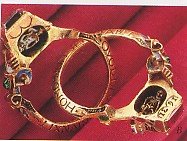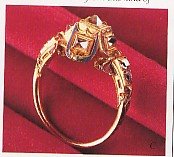
The Gift of LOVE...
...the 17th Century
The technical skills of Renaissance goldsmiths now produced a new stlye of marriage ring, the gimmel (from the Latin 'gemalli' - twins). The gimmel, or twin ring, has two hoops, sometimes three, fanning open from a pivot at the base. When shut, the hoops slide together so perfectly that only a single ring can be seen. This symbolic allusion to marriage was further emphasised by an inscription on hoop taken from the marriage service: "WHOM GOD HAS JOINED TOGETHER LET NO MAN PUT ASUNDER." Martin Luther married Catherine Bora 1525 with just such an inscribed gimmel ring at Amsdoff's House in Wittenberg .

At a dintinct remove from this kind of sentiment, a sharp, pointed diamond in a ring was much coverted for writing on glass. This whimsical form of flirtation was enjoyed by many of nobility, including Elixabeth I who exchanged crytic words on a window pane with Sir Walter Raleigh:
"Fain would I rise, but that I fear to fall"
To which Elizabeth scratched this reply:
" If thy heart fail thee, Do not rise at all."
Althogh the diamond enjoyed high esteem in the 16th century, even more of its beauty was revealed in the next.
Around 1600, the gimmel merged with another romantic symbol, the two clasped hands of the fede ( Italian for 'faith' ). The entwined gimmel hoops ended in hands which, when the ring was closed, joined together. To these symbols was added a third, the heart. In especially eloborate rings a pair of enamelled hands embrace a large diamond heart.
Other 17 century rings are ornamented with hearts aflamed with desire, pierced by Cupid's arrows crowned as fidelity's just reward held in a single hand, or clasped in a pair of hands. These designs were set with rose and table-cut diamonds. Gustavos Adolphus of Sweden gave his sweetheart Ebba Brahe, an exquisite ruby heart encircled with diamonds as a love ring.
In complete contrast, to this atmosphere in which romantic symbols were fashionable, the Puritans, reacting against Church ritual, tried hard to have wedding ring abolished. They were not successful.
Although posy rings enamelled with sprays of flowers with the inscriptions inside the hoops were most often used for 17th century weddings, diamond marriage rings still had great appeal. At the proxy marriage of Mary of Modena with James 2nd in 1673, a large diamond, probably rose-cut was placed on the fifteen-year-old bride's finger. When their son, James Stuart (the old Pretender to the English Throne) married the Polish princess Clementina Sobiska in Italy, 1719, the same ring was used at the ceremony.
17th century wedding rings were often worn on the thumb although during the wedding service the requisite fourth finger was used. This custom of placing the ring on the fourth finger stands from the preist in the Christian wedding service touching three fingers of the left hand with the ring: "In the name of the Father...Son...and Holy Ghost," ending with the ring on the fourth finger.
A more romantic legend has it that vein from the fourth finger leads directly to the heart, seat of love.
In 1668, we find Samuel Pepys writing that his aunt is "mighty proud of her wedding ring lately set with diamond." The loquacious Samuel also records that posy rings were still a firmly established wedding custom-noting that while the roast lamb was cooking, his family passed the time woking out the poem for Roger Pepy's wedding ring.
Much thought was given to the composition of this posies. Some reflect the strict morality of their Puritan influence were weighty religious aspirations:
"Pray God make us such a pair
As Isaac and Rebecca were."
But many more have charm and wit:
"Love him who give thee
This ring of gold ,
For he must kiss thee
When thou art old."
Relatively, quiet sparkle of the 17th century diamond ring, the clusters of small stones table or rose-cut rimmed in gold and enamelled in black or blue with white highlights, have a gentle beauty and dignity which makes love rings from this period especially attaractive.


0 Comments:
Post a Comment
<< Home